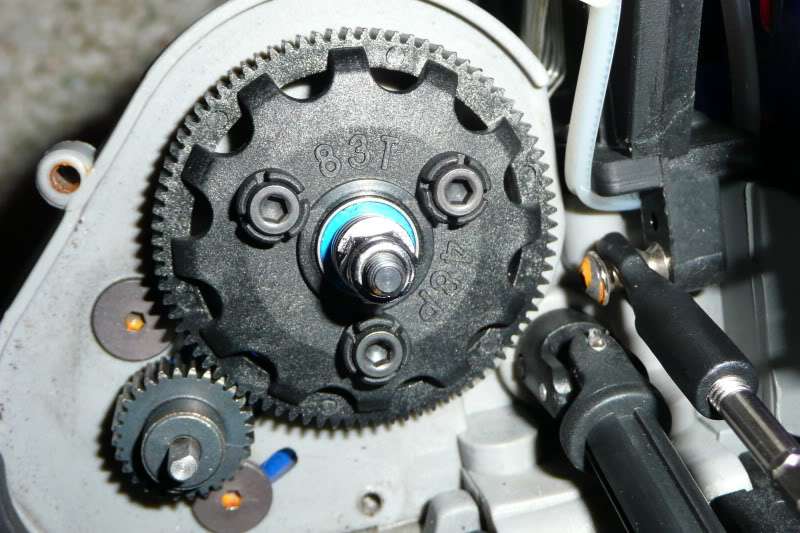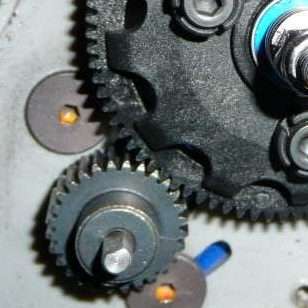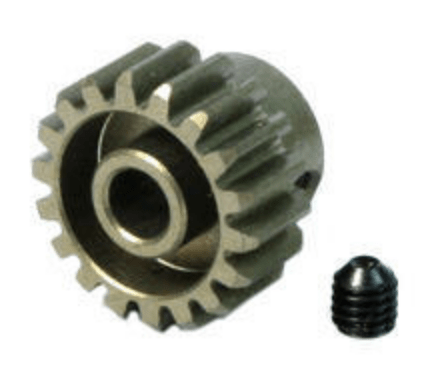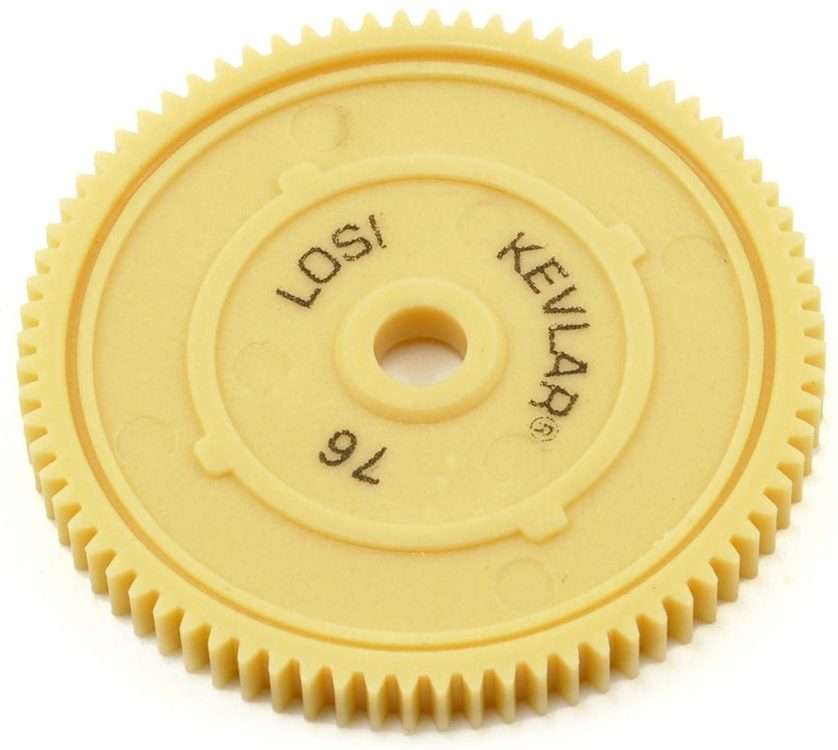Changing the gearing (or gear ratio) is one of the easiest ways to alter the performance of your RC car. You can gear for a higher top speed (more RPM), or faster acceleration (More Torque/Pulling power), for example.
How to change the Gear Ratio
You can alter your car’s gear ratio by using a different size pinion or spur gear.
The pinion gear is the very small gear fitted to the motor and is usually made from some kind of metal. Common metals include Aluminium, Steel and Titanium.
The spur gear is the larger gear that the pinion turns. These are often made from plastic and sometimes composites or Kevlar on high end RC car kits.
Changing the pinion gear will have a more noticeable effect, so if you want to make more subtle changes, change the spur gear. Change both for maximum effect or fine adjustments.

Number of Teeth
The photo above shows some markings on the spur gear; 83T, indicating it has 83 teeth. Pinion gears usually have the number etched on them too, but some manufacturers omit this.
Pitch (size of teeth)
Again, in the photo above you can see 48P written on the Spur gear – P (or DP) indicates the pitch, or size, of each tooth on the gear. 48dp is a common size for 1/10th competition cars. The higher the pitch, the smaller the teeth. You will need to use the correct pitch for your particular car, so be sure to check the manual if in doubt.
How changing gear affects the performance
Gear Ratios Explained
The number of teeth on each gear affects how many times the pinion gear needs to rotate to turn the spur gear one full rotation (hence why it is called the gear ratio).
If the pinion turns many times to one spur rotation this is called a high ratio and results in more torque, but reduces top speed. So, confusingly, a high ratio is also called a ‘low gear‘ and a low ratio is a ‘high gear’, probably linked to real cars where a higher gear just means a higher top speed.
| Low Gear (High Gear Ratio) | High Gear (Low Gear Ratio) |
|---|---|
| Faster Acceleration | Higher Top Speed |
| More Torque (Pulling power) | Less Torque |
| Increased run time (battery) | Reduced run time |
| Less heat from Motor & ESC | More heat from Motor & ESC |
Low Gear (High Gear Ratio):
Quicker Acceleration, Lower Top Speed
- Smaller pinion, larger spur gear.
- High Torque, Low RPM
- Quick, punchy acceleration, lower top speed.
- More pulling power – good over rough terrain
- Less strain and heat on the motor and ESC
- Longer run times from a single charge
Your car will accelerate off the mark very quickly, but the top speed it reaches won’t be as high.
The car will be easier to control at top speed, but the high torque and instant power may make the car feel aggressive, especially around the infield of the track when you are on and off the power a lot.
Higher end ESC’s allow you to program some throttle softening or punch reduction in. This can make the car much easier to drive, resulting in smoother driving and quicker lap times.
With a low gear, you’ll benefit from longer run times and cooler running temperatures on the ESC and motor. This is because less strain is being put on the motor.
High Gear (Low gear ratio):
Higher Top Speed, Slower Acceleration
- Larger pinion, Smaller spur gear.
- Low Torque, High RPM
- Slower acceleration, higher top speed.
- More strain and heat on the motor and ESC
- Shorter run times from a single charge
The car won’t accelerate as quickly but it will reach a higher top speed.
With less torque, the motor has to work harder while the car is accelerating. This extra strain on the motor will cause hotter running temperatures and higher currents flowing. This will reduce your run times per battery charge when compared to a low gear.
Gearing too high should be avoided, or measures taken to ensure the motor and ESC do not get too hot. Installing an additional fan directed at the motor and cutting some ventilation holes in the body shell should help.
Thin motor wires and cheap battery connectors can get very hot and melt if too much electrical current flows through them.
Getting the balance just right
In theory, a small, winding track with many curves or tight corners will be suited to a low gear, while a high gear will be better for a large, open track with long straights.
However, the softer acceleration of a high gear may make the car easier to drive in some situations; a low-geared car on a high grip track may feel aggressive and difficult to control for beginners.
For low grip tracks or wet/icy conditions, the ‘softer acceleration’ of a high gear can help give the car more traction, so this setup is worth considering, even on small, technical layouts.
Smooth driving will help you get those consistent lap times, so experiment to get gearing just right for the track and conditions you are racing in.
Select the correct gearing for your Motor
You are, of course, free to use any gear ratio you like. However, for best performance, and to avoid any overheating issues, the gear ratio you use should suit the motor fitted to your car.
A higher turn motor (13.5t, 17.5t etc) will have more torque but less top speed or RPM. Therefore, a higher turn motor will need a larger pinion / smaller spur gear combination to make use of all this low end torque.
Lower turn motors such as 5.5t or 8.5t will generally need to use a small pinion, large spur combination.
Your RC Car manual may provide recommendations on gear ratios for different motors and conditions.
If you find your car seems to lack power, you may be over or under geared. Check your RC car’s instruction manual to see what the recommended pinion and spur range is for your motor.
Gear Mesh
When fitting or making changes to either the pinion gear, the spur gear or the motor position, you will need to ensure the ‘gear mesh‘ is correctly set. The gear mesh is the gap between the pinion and spur gear teeth.
If the gear mesh is set too tight, the increased resistance can cause lots of problems:
- more strain on the motor and power system
- more noise
- excessive wear, especially on the spur gear
- shorter battery life
- slower car
- overheating
If the gear mesh is set too loose, the following problems can also occur:
- Pinion slipping on the spur gear
- Flat spot or excessive wear on the spur gear
To set the pinion and spur gear mesh
The best way to do this is to adjust the motor position so that the pinion is tight against the spur gear, and then back it off ever so slightly so that the spur gear ‘rocks’ against the pinion when you move the spur gear back and forth. You want a little bit of play, but not loose enough that it slips. In the photo below you can see that the teeth fit nicely together, but with a very slight gap.

Related RC Car Racing Guides:
Gearing has a similar effect to Timing. Be sure to check out my Simple Guide to Motor Timing, Boost and Turbo.


